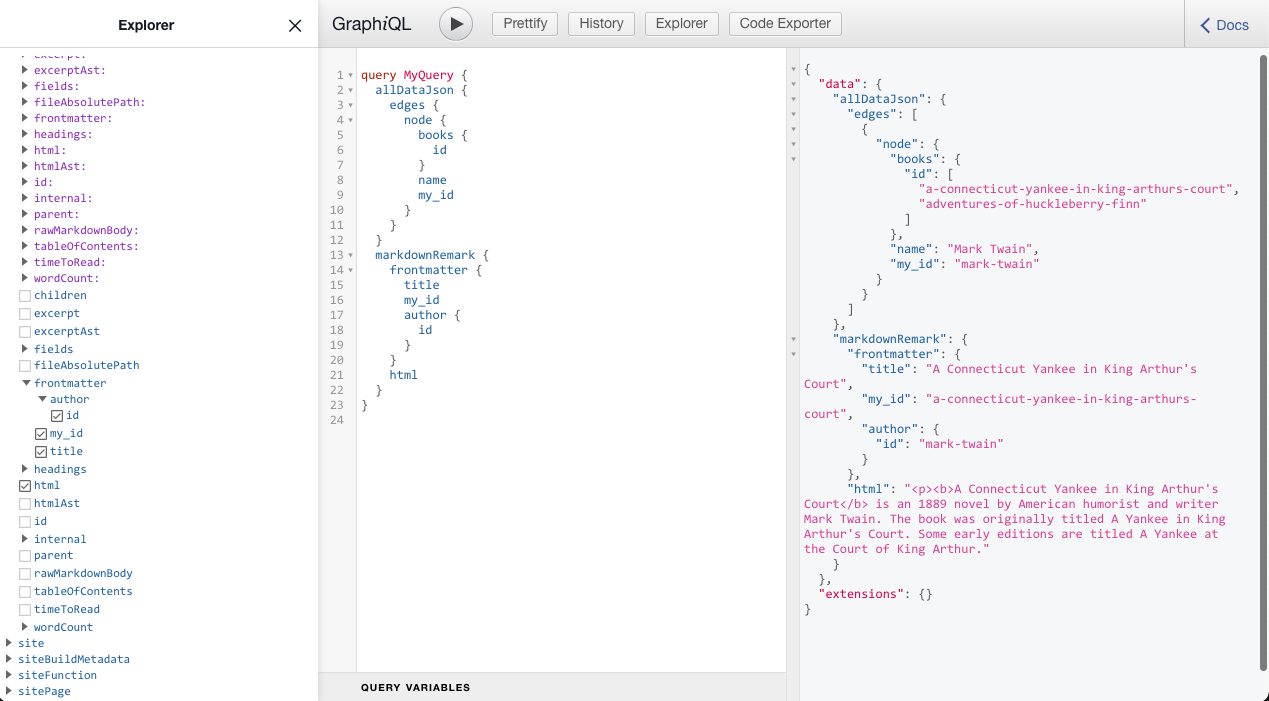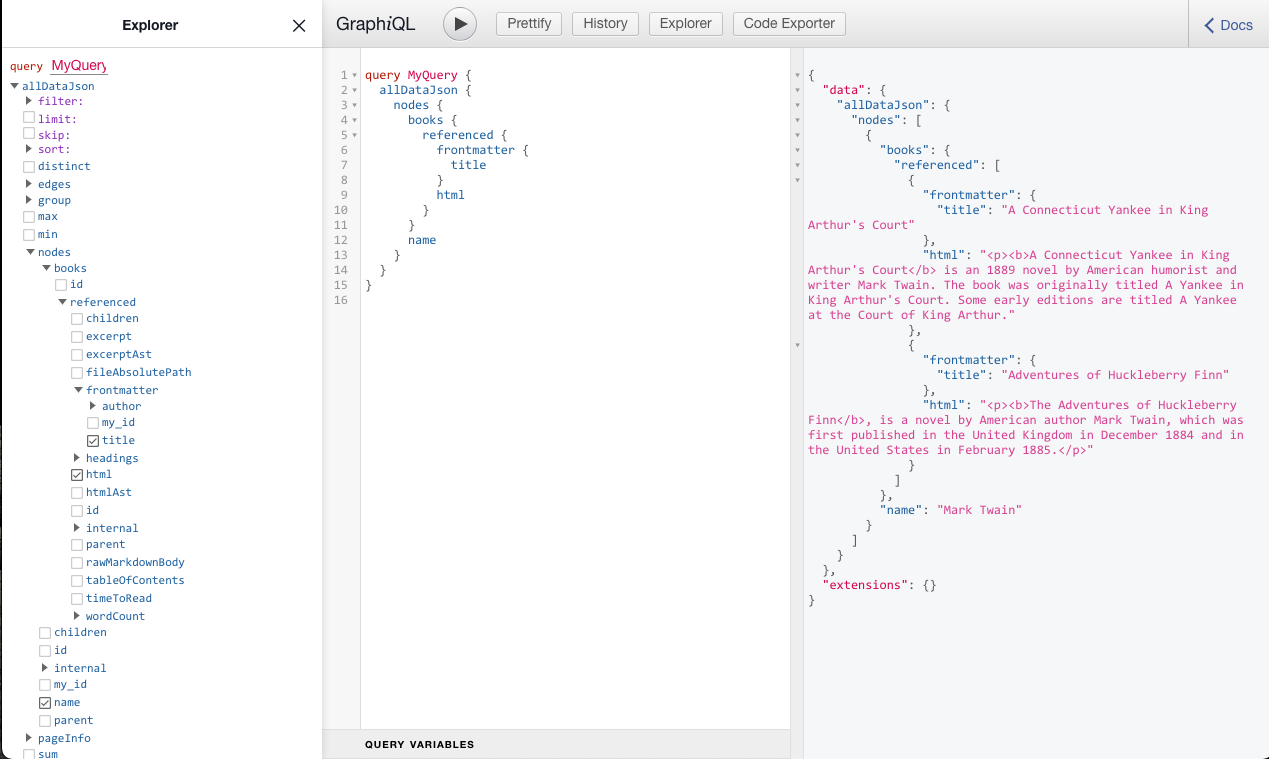
This post is a reminder to my future self of how I created a generic resolver for a Headless Drupal project.
The Gatsby docs on Customizing the GraphQL Schema is here
The setup for this example will follow the Gatsby docs and is close enough to what we would see from Drupal. The gatsby example gets Author info from JSON files and Book info from Markdown.
yarn add gatsby-transformer-remark gatsby-transformer-jsonAdd these files.
src/data/mark-twain.json
{
"my-id": "mark-twain",
"name": "Mark Twain",
"books": {
"id": [
"a-connecticut-yankee-in-king-arthurs-court",
"adventures-of-huckleberry-finn"
]
}
}And these Markdown files.
---
# src/markdown-pages/a-connecticut-yankee-in-king-arthurs-court.md
my-id: "a-connecticut-yankee-in-king-arthurs-court"
title: "A Connecticut Yankee in King Arthur's Court"
author:
id: "mark-twain"
---
## <p><b>A Connecticut Yankee in King Arthur's Court</b> is an 1889 novel by American humorist and writer Mark Twain. The book was originally titled A Yankee in King Arthur's Court. Some early editions are titled A Yankee at the Court of King Arthur.
<p><b>A Connecticut Yankee in King Arthur's Court</b> is an 1889 novel by American humorist and writer Mark Twain. The book was originally titled A Yankee in King Arthur's Court. Some early editions are titled A Yankee at the Court of King Arthur.---
# src/markdown-pages/adventures-of-huckleberry-finn.md
my-id: "adventures-of-huckleberry-finn"
title: "Adventures of Huckleberry Finn"
author:
id: "mark-twain"
---
<p><b>The Adventures of Huckleberry Finn</b>, is a novel by American author Mark Twain, which was first published in the United Kingdom in December 1884 and in the United States in February 1885.</p>Start the app to see what we are starting with.
yarn start
open http://localhost:8000/___graphqlThe GraphQL should look like this.

// gatsby/resolvers.js
const genericResolver = function genericResolver(nodeType, targetNodeType) {
return {
// this is the parent node type
[nodeType]: {
// add a new node called referenced to add the target to.
referenced: {
type: targetNodeType,
async resolve(source, args, context, info) {
// bailout if there is no id
if (!source.id) {
return null;
}
return await context.nodeModel.findOne({
query: {
filter: {
my_id: {
in: source.id,
},
},
},
type: targetNodeType,
});
},
},
},
};
};
const genericArrayResolver = function genericArrayResolver(
nodeType,
targetNodeType
) {
return {
// this is the parent node type
[nodeType]: {
// add a new node called referenced to add the target to.
referenced: {
type: [targetNodeType],
async resolve(source, args, context, info) {
// bailout if there is no id
if (!source.id || source.lenght === 0) {
return [];
}
// selecting one at a time to maintain order
const result = [];
for (const id of source.id) {
const node = await context.nodeModel.findOne({
query: {
filter: {
// this is a hack due to the example construction
// normally the ids will not be nested and you can delete `frontmatter`
frontmatter: {
my_id: {
eq: id,
},
},
},
},
type: targetNodeType,
});
result.push(node);
}
return result;
},
},
},
};
};
module.exports = {
genericArrayResolver,
genericResolver,
};// gatsby-node.js
const { genericArrayResolver, genericResolver } = require("./gatsby/resolvers");
exports.createResolvers = ({ createResolvers }) => {
const resolvers = {
...genericResolver("MarkdownRemarkFrontmatterAuthor", "DataJson"),
...genericArrayResolver("DataJsonBooks", "MarkdownRemark"),
};
createResolvers(resolvers);
};The GraphQL should look like this.

import * as React from "react";
import { graphql } from "gatsby";
import Layout from "../components/layout";
const IndexPage = ({ data }) => (
<Layout>
<div>
<h1>
Welcome to <b>Resolver Example</b>
</h1>
{data.allDataJson.nodes.map((author) => (
<div>
<h4>{author.name}</h4>
{author.books.referenced.map((book) => (
<p>{book.frontmatter.title}</p>
))}
</div>
))}
</div>
</Layout>
);
export default IndexPage;
export const pageQuery = graphql`
query AuthorQuery {
allDataJson {
nodes {
books {
referenced {
frontmatter {
title
}
html
}
}
name
}
}
}
`;